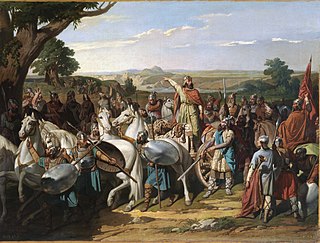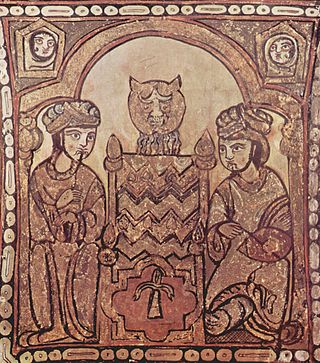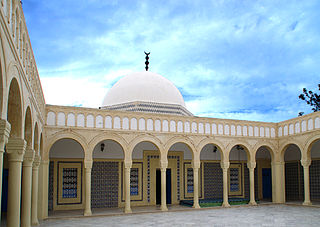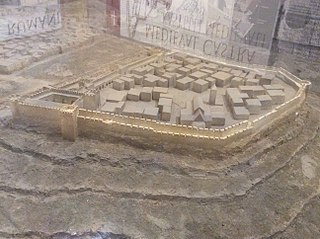
The term Moor is an exonym first used by Christian Europeans to designate the Muslim populations of the Maghreb, al-Andalus, Sicily and Malta during the Middle Ages. Moors are not a single, distinct or self-defined people. The 1911 Encyclopædia Britannica observed that the term had "no real ethnological value." Europeans of the Middle Ages and the early modern period variously applied the name to Arabs, Berbers, and Muslim Europeans.

Roger I, nicknamed “Roger Bosso” and “Grand Count Roger”, was a Norman nobleman who became the first Grand Count of Sicily from 1071 to 1101.

Septimania is a historical region in modern-day southern France. It referred to the western part of the Roman province of Gallia Narbonensis that passed to the control of the Visigoths in 462, when Septimania was ceded to their king, Theodoric II. During the Early Middle Ages, the region was variously known as Gallia Narbonensis, Gallia, or Narbonensis. The territory of Septimania roughly corresponds with the modern French former administrative region of Languedoc-Roussillon that merged into the new administrative region of Occitanie. In the Visigothic Kingdom, which became centred on Toledo by the end of the reign of Leovigild, Septimania was both an administrative province of the central royal government and an ecclesiastical province whose metropolitan was the Archbishop of Narbonne. Originally, the Goths may have maintained their hold on the Albigeois, but if so it was conquered by the time of Chilperic I. There is archaeological evidence that some enclaves of Visigothic population remained in Frankish Gaul, near the Septimanian border, after 507.

Al-Andalus was the Muslim-ruled area of the Iberian Peninsula. The term is used by modern historians for the former Islamic states in modern-day Gibraltar, Portugal, Spain, and Southern France. The name describes the different Muslim states that controlled these territories at various times between 711 and 1492. At its greatest geographical extent, it occupied most of the peninsula and part of present-day southern France (Septimania) under Umayyad rule. These boundaries changed constantly through a series of conquests Western historiography has traditionally characterized as the Reconquista, eventually shrinking to the south and finally to the Emirate of Granada.

Enna, known from the Middle Ages until 1926 as Castrogiovanni, is a city and comune located roughly at the center of Sicily, southern Italy, in the province of Enna, towering above the surrounding countryside. It has earned the nicknames belvedere and ombelico ("navel") of Sicily.

The Muslim conquest of the Iberian Peninsula, also known as the Arab conquest of Spain, by the Umayyad Caliphate occurred between approximately 711 and the 720s. The conquest resulted in the defeat of the Visigothic Kingdom and the establishment of the Umayyad Wilayah of Al-Andalus.

The Arab conquest of Egypt, led by the army of 'Amr ibn al-'As, took place between 639 and 642 AD and was overseen by the Rashidun Caliphate. It ended the seven-century-long Roman period in Egypt that began in 30 BC, and widely speaking Greco-Roman period that had lasted about a millennium.

The early Muslim conquests or early Islamic conquests, also known as the Arab conquests, were initiated in the 7th century by Muhammad, the founder of Islam. He established a new unified polity in Arabia that expanded rapidly under the Rashidun Caliphate and the Umayyad Caliphate, culminating in Muslim rule being established on three continents over the next century. According to Scottish historian James Buchan: "In speed and extent, the first Arab conquests were matched only by those of Alexander the Great, and they were more lasting."

Martín Leandro Castrogiovanni is an Italian-Argentine retired rugby union player. He was born in Paraná, Argentina, but qualified for Italy through his heritage. Castrogiovanni moved to Italy as a teenager and represented the Italian national team 119 times over 14 years. In Italy he played for Calvisano between 2001 and 2006, before moving to England to play for Leicester Tigers where he played 145 games over seven seasons, winning four Premiership Rugby titles. In 2013 he moved to Toulon where he won a Heineken Cup, before finishing his career with Racing 92 in Paris.

The Emirate of Sicily or Fatimid Sicily was an Islamic kingdom that ruled the Muslim territories on the island of Sicily between 831 and 1091. Its capital was Palermo, which, during this period, became a major cultural and political center of the Muslim world.

George of Antioch was a court official and military officer in the Norman Kingdom of Sicily that played a significant role in the transformation of Norman Sicily into a multicultural society and naval power. He did so as chiefly as an advisor to Roger II of Sicily. He was a Greek Eastern Orthodox Christian from the Byzantine Empire. George lived in Antioch for a part of his life before he and his family found work with the Byzantine Emperor Alexios Komnenos until their exile from the Empire. He and his family then worked for the Emir of Ifriqiya, Tamim ibn al-Muizz, becoming governor of the city of Sousse. After the death of George's brother at the hands of Tamim's successor, Yahya, George fled the court and found refuge in Norman Sicily. There he spent the remainder of his life, serving as both an administrator and military commander with profound influence within the Kingdom of Sicily until his death.

The history of Islam in Sicily and southern Italy began with the first Arab settlement in Sicily, at Mazara, which was captured in 827. The subsequent rule of Sicily and Malta started in the 10th century. The Emirate of Sicily lasted from 831 until 1061, and controlled the whole island by 902. Though Sicily was the primary Muslim stronghold in Italy, some temporary footholds, the most substantial of which was the port city of Bari, were established on the mainland peninsula, especially in mainland southern Italy, though Muslim raids, mainly those of Muhammad I ibn al-Aghlab, reached as far north as Naples, Rome and the northern region of Piedmont. The Arab raids were part of a larger struggle for power in Italy and Europe, with Christian Byzantine, Frankish, Norman and local Italian forces also competing for control. Arabs were sometimes sought as allies by various Christian factions against other factions.

The Norman conquest of southern Italy lasted from 999 to 1194, involving many battles and independent conquerors.

The term Norman–Arab–Byzantine culture, Norman–Sicilian culture or, less inclusively, Norman–Arab culture, refers to the interaction of the Norman, Byzantine Greek, Latin, and Arab cultures following the Norman conquest of the former Emirate of Sicily and North Africa from 1061 to around 1250. The civilization resulted from numerous exchanges in the cultural and scientific fields, based on the tolerance shown by the Normans towards the Latin- and Greek-speaking Christian populations and the former Arab Muslim settlers. As a result, Sicily under the Normans became a crossroad for the interaction between the Norman and Latin Catholic, Byzantine–Orthodox, and Arab–Islamic cultures.

The County of Sicily, also known as County of Sicily and Calabria, was a Norman state comprising the islands of Sicily and Malta and part of Calabria from 1071 until 1130. The county began to form during the Christian reconquest of Sicily (1061–91) from the Muslim Emirate, established by conquest in 965. The county is thus a transitional period in the history of Sicily. After the Muslims had been defeated and either forced out or incorporated into the Norman military, a further period of transition took place for the county and the Sicilians.

Quds Day, officially known as International Quds Day, is an annual pro-Palestinian event held on the last Friday of the Islamic holy month of Ramadan to express support for Palestinians and oppose Israel and Zionism. It takes its name from the Arabic name for Jerusalem: al-Quds.

Muhammad ibn Ali ibn Omar ibn Muhammad al-Tamimi al-Maziri, simply known as Al-Maziri or as Imam al-Maziri and Imam al-Mazari, was an important Arab Muslim jurist in the Maliki school of Sunni Islamic Law. He was one of the most important figures in the school and his opinions are well known and respected to this day. Al-Maziri was one of four jurists whose positions were held as authoritative by Khalil ibn Ishaq in his Mukhtassar, which is the most important of the later texts in the relied upon positions of the school. It is for this reason that he is referred to simply as al-Imam within the Maliki school.

During the Muslim rule on Sicily, the island was divided into three different administrative regions: the Val di Noto in the southeast, the Val Demone in the northeast and the Val di Mazara in the west. Each zone has a noticeably different agriculture and topography and they converged near Enna (Castrogiovanni).

The Battle of Cerami was fought in June 1063 and was one of the most significant battles in the Norman conquest of Sicily, 1060–1091. The battle was fought between a Norman expeditionary force and a Muslim alliance of Sicilian and Zirid troops. The Normans fought under the command of Roger de Hauteville, the youngest son of Tancred of Hauteville and brother of Robert Guiscard. The Muslim alliance consisted of the native Sicilian Muslims under the Kalbid ruling class of Palermo, led by Ibn al-Hawas, and Zirid reinforcements from North Africa led by the two princes, Ayyub and 'Ali. The battle was a resounding Norman victory that utterly routed the opposing force, causing divisions amongst the Muslim aristocracy which ultimately paved the way for the eventual capture of the Sicilian capital, Palermo, by the Normans and subsequently the rest of the island.

The Norman invasion of Malta was an attack on the island of Malta, then inhabited predominantly by Muslims, by forces of the Norman County of Sicily led by Roger I in 1091. The invaders besieged Medina, the main settlement on the island, but the inhabitants managed to negotiate peace terms. The Muslims freed Christian captives, swore an oath of loyalty to Roger and paid him an annual tribute. Roger's army then sacked Gozo and returned to Sicily with the freed captives.



















